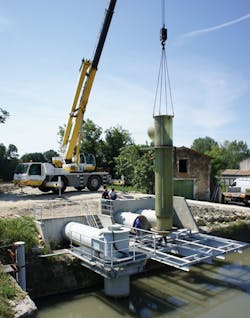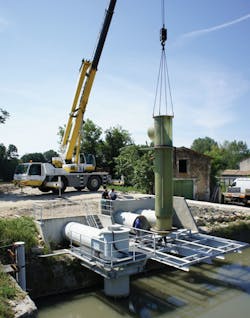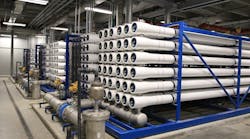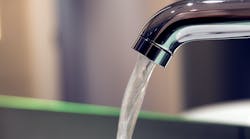In 2013 a €9 million environmental engineering programme involving more than doubling the total capacity of seven pumping stations in the Petit Camargue, France, was completed. The flood prevention strategy, which had started back in 2003, involved the pump engineering and construction resources of KSB SAS.
By Bryan Orchard
The Petite Camargue lies in the Languedoc-Roussillon Region in southern France between the Mediterranean Sea and the right side of the Petit Rhone, one of the two arms of the Rhône River Delta. Covering an area of 55,000 hectares, of which 38,000 hectares comprise wetlands, the Petite Camargue is largely given over to agriculture and fisheries, while its very special flora and fauna make it a haven for wildlife and tourism.
With large areas of the Petite Camargue lying some two meters below sea level, it is prone to regular flooding, resulting from the rising levels of the rivers Vistre, Vidourle and Rhône, and sometimes by breaks in the dykes.
The earth of the wetlands is naturally saturated so in the event of great floods, when water courses rise above river and drainage channel banks, some 300km² of the Petite Camargue can be transformed into a massive overflow area. Basically, this means that the water gathers here until it flows or drains off again. Such a process that can take a considerable amount of time and at a considerable cost to the local communities.
As land reclaimed from the sea, the Petite Camargue has been drained, both manually and by drainage structures for several centuries. More recently pumping stations have eased the burden, with the flood water being initially pumped from the flooded areas and then fed into the Rhône where it flows into the sea. However, in the past 20 years, these pumping stations have proved to be inadequate when put to the ultimate test.
Intense flooding occurred in 1993 and 1994, and as a result a special body, Syndicat Mixte de la Camargue Gardoise (SMCG), was established with the eight communities affected to address the problem. Eventually in 1998 a further public body was created to thoroughly investigate how to reduce the risks of flooding, with the results expected by 2003. However, in September 2002, flooding of the Rhône upstream occurred and this had a serious affect on the region. This was followed in December 2003 when flooding on the Rhône and its main tributaries took on considerable, even historical, dimensions.
In the lower course of the Rhône, which runs in part along the Petite Camargue, 2003 was the third-largest known flood, even greater that the two floods of 1840 and 1856 which had massive effects on the region.
In Beaucaire, which is situated several kilometres north of the Petite Camargue, floods peaked at 11,500 m³/s. In the lower course of the Rhône it took several days, in some parts even several weeks, before the water flowed into the sea.
Some residential areas were four meters underwater and, on both sides of the river, 32,000 people had to be evacuated. The floods covered 30,000 ha, caused damage worth an estimated €300 million and took more than three months to pump clear.
Action plan
As a result of this human and environmental catastrophe, a project – 'Camargue Gaudoise' was initiated in 2005 which, although not being able to completely prevent flooding, would limit damage to land and property. The main objective of the project was to shorten the time in which the area from Saint-Gilles to Le Grau du Roi remains underwater.
That plan involved the construction of 11 hydraulic stations, five reinforced pumping stations and one completely new pumping station, in effect doubling pumping to 45.3m³/sec. This infrastructure investment considerably increases the volume of water that can be drained and significantly reduces the length of time that water remains in overflow areas by draining the land more quickly.
Due to the complexity of the project and the number of organisations and suppliers involved, work did not commence on the construction until 2011. While there were many engineering and environmental assessments to be made, the central issue to the success of the project was the hydraulics and their infrastructure.
Having earlier extended the pump station at La Souteyranne/Liviers in 2006 with additional pumps, pump manufacturer KSB S.A.S. took a lead role and secured the project contract in 2010.
From the outset of the project it was recognised that technical adaptations to the various pumping stations would be necessary in order to provide optimum performance for the pumps.
Examples of this include extending the La Fosse pumping station to increase drainage by a further 3 m³/s; planning and equipping a new pumping station at the end of the Canal de Capette to increase drainage by a further 9 m³/sec and refurbishing the pumping stations at Souteyranne/Mas Livers, La Cave/Le Mole, Sylvéréal and Bourgidou/Aigues-Mortes in order to adapt to their new drainage volumes.
Each pumping station had its own special requirements, which in certain cases required KSB S.A.S. to simulate flow conditions to evaluate and test its civil engineering structures in order to ensure that the pumps would fulfil their duties. At Sylvéréal, it was necessary to construct special inlet chambers in the feed basin in which the pumps were installed to counter the vortex effects on the water surface which could damage the pumps.
At the la Cave/Le Mole station, a special 'tulip'- shaped cone was designed and constructed at the end of the tube in which the pump was installed in order to give greater suction. Coupled with all these engineering works was the need to equip each pumping station with secure control panels for the remote operation of the pumps.
At the completion of the engineering and construction programme, KSB engineers had installed and commissioned 13 Amacan pumps with flows ranging from 0.5 m³/sec to 4 m³/sec, increasing the drainage pumping capability of the Petit Camargue from 19.8 m³/sec to 45.3 m³/sec.
The supplied pumps are close-coupled, wet-installed single entry axial open impeller pump where the impeller is located in a tubular casing immersed in the water. Explosion protected to ATEX II G2 T3, the pump has a maximum flow capacity of up to 7,000 l/sec and a maximum head of 12m.
As a result of this major investment, which was jointly financed by Europe, the French State, the region of Languedoc-Roussillon, the Department Garde and the 'Syndicat Mixte Départmental des Milieux Aquatiques', the SMCG now has a robust flood prevention scheme that is capable of handling the flood levels encountered in 2003.
Bryan Orchard is an industry communications and PR specialist who specialises in pumps.
Email: [email protected].




